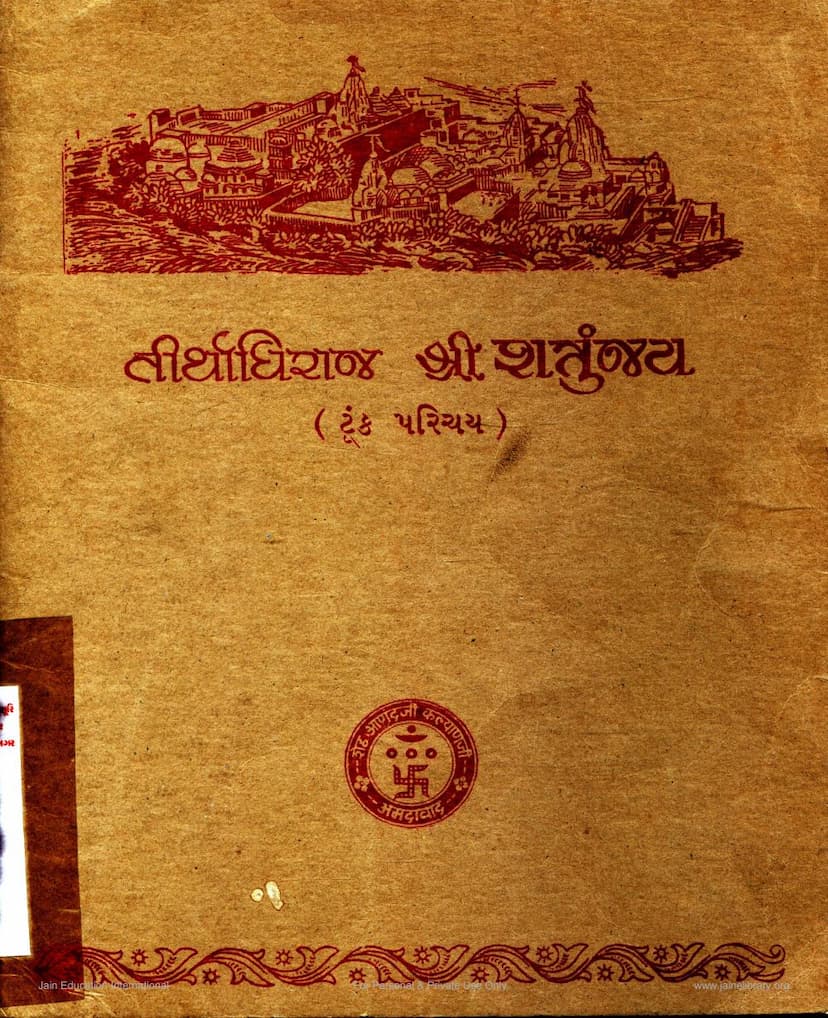Tirthadhiraj Shree Shatrunjay
Added to library: September 2, 2025

Summary
This document is a brief introduction to the Shree Shatrunjay Mahatirth, a prominent Jain pilgrimage site located in Saurashtra. It is presented by the Anandji Kalyanji Pedhi and aims to provide essential information about this holy place.
Here's a summary of the key points covered in the text:
-
Significance of Shatrunjay: It is described as a highly sacred Jain site, the land of liberation for great souls like Gnadhar Pundrikadi, and adorned with the grand temple of the first Tirthankar, Bhagwan Yugadideva.
-
Historical Context:
- The text mentions that the mountain has been described in ancient Jain scriptures like "Gnatadharma Katha" and "Antakritsutra."
- It highlights the reconstruction and renovation efforts by various historical figures and patrons, including Mauryan king Samprati, Satavahana, Vikramaditya, and merchants like Javadishah.
- There's a mention of the mountain being under Buddhist control for some time during the Maitraka era and later returning to Jain control under King Shiladitya V.
- Significant renovations and constructions were undertaken by ministers and merchants like Udayanaputra Amatya Vagbhatta, Mahamatya Vastupal-Tejpal, Jagadushah, Pethad, and Pithad.
- The text details the contributions of various communities and individuals from different eras, including the Mughal and British periods, in building new temples and renovating existing ones.
-
Destruction and Reconstruction: The text acknowledges that the temple complex has faced destruction during Muslim invasions, including during the time of Mahmud Ghaznavi, Khilji Al Khan, and possibly Aurangzeb. This led to the destruction of many ancient idols and temples. However, it also emphasizes the continuous efforts of devotees in renovating and rebuilding these sacred structures.
-
Architectural Styles: The temples on Shatrunjay are noted for being constructed in the Maru-Gurjar style, prevalent during the Solanki and Anahilavada periods.
-
Key Figures in Renovation: Prominent individuals involved in the renovation and construction of temples mentioned include:
- Samarsinh or Samrashah (15th-century renovator)
- Sheth Karmashah (16th-century renovator)
- Minister Tejpal (built 'Anupam-Savar' and 'Swargarohan Prasad')
- Minister Vastupal (built temples and the 'Lalitadevi' lake)
- Jagadushah (merchant from Kutch)
- Pethad and Pithad (Ministers)
- Anandji Kalyanji (modern-day patrons who built new pathways)
-
Notable Temples and Structures: The text provides descriptions and mentions of various temples and structures on the Shatrunjay hill, including:
- Vimalvashi (or Bhulavani) Temple (Kharatarvashi): Considered one of the most beautiful, it features 72 smaller shrines around the main complex. It is attributed to Vimal, the minister of Bhimdev I, though literary evidence suggests it was originally known as Kharatarvashi.
- Kumar Pal's Temple (Kharatar-Gachchhiya Yugadidev Temple): Though believed to be built by King Kumarpal, evidence suggests it was constructed in the 14th century under the inspiration of a Kharatar Gachchha acharya.
- Shree Aadi Shwar Bhagwan's Cluster of Temples: This is considered the most sacred area. It mentions the reconstruction of the ancient temple of Aadi Shwar Bhagwan by Amatya Vagbhatta and later additions by Vastupal and others.
- Nav Took (Nine Clusters): The text describes various clusters of temples, including the Chau mukhji cluster, the Kharatarvashi cluster, the Chhipavsahi cluster, and the Sakharvasi cluster, detailing the temples and patrons associated with each.
- Balaasi's Temple Complex: Built by Seth Deepchand Kalyanji, it includes temples of Rishabhdev, Pundrik Swami, and a Chau mukhji temple.
- Motisha Seth's Cluster: Located between the two peaks of Shatrunjay, it houses several temples, including those of Aadi Shwar, Pundrikji, Dharma Nath, Padma Prabh, Parshvanath, and Sumati Nath.
- "Adbhut Aadinath" (Wonderful Aadinath): A 12-hand high idol carved on the rock, re-consecrated in 1630 CE.
-
Paliatana Town: The town at the foot of Shatrunjay is also mentioned as ancient, possibly named after Jainacharya Padaliptasuri. It details the construction of 'Kumarpur' (later 'Vagbhattpur') and the temple of Bhagwan Parshvanath by minister Vagbhatta.
-
Pathways and Gates: The text describes the paths and gates leading up the mountain, including 'Sanchar Paja' built by Tejpal, 'Ram Pol' (formerly 'Simhadwar'), and 'Hathipol'.
-
Pilgrimage Route: It mentions the traditional pilgrimage route starting from Jayataleti and the practice of circumambulating the nine clusters.
In essence, the book "Tirthadhiraj Shree Shatrunjay" serves as a concise historical and architectural guide to the magnificent Shatrunjay pilgrimage site, highlighting its rich legacy, the challenges it has faced, and the enduring devotion that has shaped its present form.